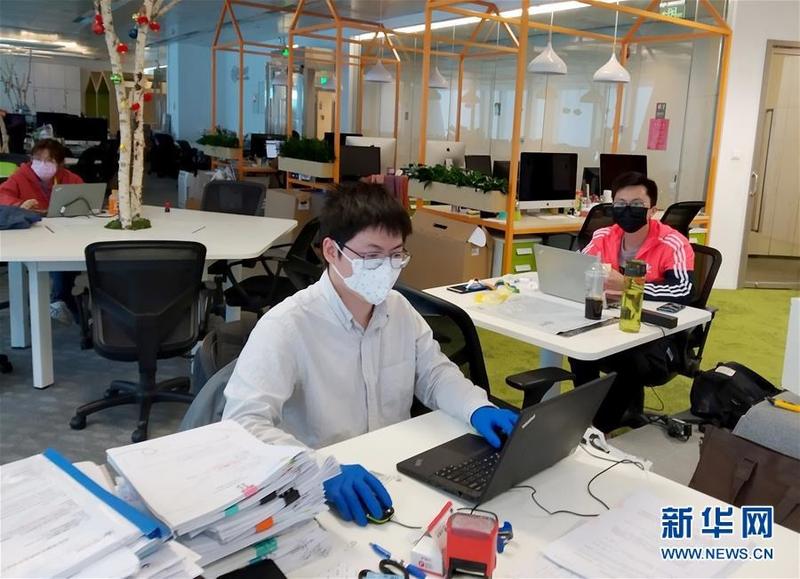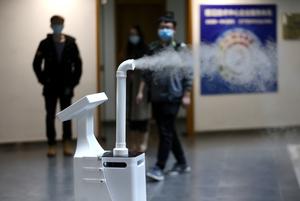Trend of working from home looks certain to stay
 Employees resume work at an overseas company in Guangzhou, Guangdong province, in February. (LU HANXIN / XINHUA)
Employees resume work at an overseas company in Guangzhou, Guangdong province, in February. (LU HANXIN / XINHUA)
Short of dipping an entire office in boiling water to sterilize it, a virus-free work environment is impossible.
However, designers have come up with ideas about limiting the risk of infection by the novel coronavirus pandemic-with the office as we know it likely to change.
The open floor plan, adopted by many companies before the outbreak, will probably disappear, along with small meeting rooms, kitchens and common relaxation areas. Ventilation systems are likely to be viewed as inadequate in promoting health.
The company gym is also likely to vanish.
Most assumptions about office layout are being challenged. It is unclear how this situation will develop as employers and employees seek to limit the threat posed by the coronavirus.
Kate Lister, president of United States consulting company Global Workplace Analytics in San Diego, California, said: "We've got to ask the questions. We don't yet have all the answers."
The idea behind the open floor plan, championed by architect Frank Lloyd Wright in the 1930s, is simple. It entails creating a collaborative atmosphere, sparking an exchange of ideas and eliminating a rigid hierarchy ruled by supervisors in private offices with their names on the doors while workers labor anonymously in confined spaces.
Fear of contagion is likely to consign this idea to history, and rigidly defined areas may return to the office, upending current designs.
 A robot disinfects a company in the Zhongguancun area in Beijing. (ZOU HONG / CHINA DAILY)
A robot disinfects a company in the Zhongguancun area in Beijing. (ZOU HONG / CHINA DAILY)
The American Institute of Architects, drawing on research by the US Centers for Disease Control and Prevention, recommends partitions to subdivide large working areas, increased spacing of desks, and the use of antimicrobial coatings on surfaces routinely touched by employees.
Sneeze guards are likely to become common. At many supermarkets, a Plexiglass shield now separates the customer from the cashier. Similar barriers may be installed between desks.
Paradoxically, that would mimic the cubicle that walled employees on three sides and created a sense of isolation among some, which has been parodied in movies and comic strips.
Hand sanitizers are likely to be used widely in the post-pandemic office, becoming a fixture on desks and positioned at key points throughout the building. Some employers may require the use of face masks and latex gloves at work.
Offices are likely to be cleaned more often, including the use of virus-killing ultraviolet light to disinfect surfaces. Touch-free technology, such as automatic doors, may gradually replace door handles. If possible, interior hallways and doorways are likely to be widened.
The World Economic Forum reported that Cushman & Wakefield, an international commercial real estate services company, has a simple solution-a disposable paper covering on desks, to be discarded at the end of each day.
Arrows may be placed on floors to regulate the flow of workers and maintain social distancing. One-way aisles may result in taking the long way around to get to a destination, but most employees are likely to be willing to trade a little inconvenience for a reduced risk of infection.
 Employees at a Toyota branch in Valenciennes, France, maintain social distancing after returning to work in April. (PHOTO / XINHUA)
Employees at a Toyota branch in Valenciennes, France, maintain social distancing after returning to work in April. (PHOTO / XINHUA)
Need for fresh air
Joseph Allen, an assistant professor at Harvard University's T.H.Chan School of Public Health and director of its Healthy Buildings program, said the pandemic will force a change in the design of air circulation systems in office buildings.
"For the past several decades, we have choked off the air supply in our buildings to conserve energy," he told the Harvard Gazette, the university's official news outlet.
"We aren't bringing in enough outdoor air, which means indoor pollutants can concentrate. You want to try to get 100 percent outdoor air being brought into your system, with no recirculated air."
A Harvard University study concluded that better ventilation could boost productivity by as much as US$7,500 per year for each employee and reduce the number of days a worker stays home sick.
Researchers at Lawrence Berkeley National Laboratory in California estimated that improving indoor air quality could raise US productivity by as much as US$20 billion a year.
That may mean reviving an old idea-windows that open. Fresh air would be able to circulate in the office, reducing the risk of the air-conditioning system blowing potentially infected air over everybody. But some workers might object on hot summer days, while few would tolerate an open window during winter.
The answer may be improved filters in the air ducts of a building's heating and air-conditioning system. However, filters capable of trapping a virus would be expensive to buy, install and maintain.
Humidifiers may become standard office fixtures, because moist air may inhibit the spread of a virus.
 A cleaner disinfects a Shanghai office building in February. (LIU YING / XINHUA)
A cleaner disinfects a Shanghai office building in February. (LIU YING / XINHUA)
Elevators problem
People will probably want to avoid standing shoulder-to-shoulder in elevators, as they have in the past. It is also unlikely that all workers will be sufficiently self-disciplined to wait for the next elevator when it's time to go home.
Voice-activated floor selection in elevators would eliminate the need to push a button, but would be expensive to install. Will employees willingly don gloves in the lobby each morning? In low-rise buildings, will a significant number of workers rediscover the stairs?
The short answer to these questions is that no one knows. But the first changes are likely to be small, such as eliminating the snack and coffee bars that have been the hallmark of prestigious offices.
Lister, from Global Workplace Analytics, said: "Changes will come in three phases: interim, mid-term and long-term. Long-term, we should ask: do we need all that office space?"
The key step in limiting the risk of infection is having fewer people in the office. That almost certainly means more employees working from home several days a week and shifts being staggered to avoid cramming all staff members into limited space.
But as a result, companies would face paying for under-used space and might feel compelled to reduce the office area, defeating social distancing efforts.
Furniture design
Padded chairs may gradually disappear and be replaced by wooden or plastic ones that can be easily disinfected. Benches may replace couches in common areas, and the use of such areas may be limited to only a few people at a time.
Lowering the risk of contagion probably means the end of most staff meetings. If a conference room is not big enough to permit adequate social distancing, such meetings are likely to be held by email, instant messaging or videoconferencing.
If everyone in an office becomes germophobic, the problem of pressing the print button on a photocopier will need solving.
Testing employees each morning as they report for work may be an effective way to prevent the spread of disease.
The test may be self-administered and employees could be required to keep a record of their temperature and general health as a condition of employment, which could raise privacy concerns.
Sending potentially sick workers home with pay, with no pressure to return to work, might be effective, but it would also be expensive if there are false readings.
In the book Healthy Buildings: How Indoor Spaces Drive Performance and Productivity, Allen, from Harvard University, and colleague John Macomber make a basic point-there is no such thing as zero risk. The goal is to minimize risk.
 Police officers eat lunch at a canteen in Zhoushan, Zhejiang province. (ZOU XUNYONG / FOR CHINA DAILY)
Police officers eat lunch at a canteen in Zhoushan, Zhejiang province. (ZOU XUNYONG / FOR CHINA DAILY)
Working from home
People will continue to go to an office for work, but researchers believe that more employees may complete their tasks from home two or three days a week to reduce office headcount and lower the infection risk.
The pandemic appears to have created strong economic incentives to disperse workforces and reduce the importance of the office.
Lister said working from home half the time would save each employee between US$2,500 and US$4,000 a year on commuting, food and parking. Reduced commuting time would save an employee working from home the equivalent of 11 days a year.
"Home will become a place for increased productivity and more contemplative work-even with the cacophony of children and pets," Lister said.
Moving staff members out of the office and allowing them to work from home several days a week could save employers as much as US$11,000 a year per employee by reducing office headcount and cutting other in-house expenses.
Working from home would also likely reduce sexual harassment, a continuing outrage for women and an increasingly expensive problem for employers in terms of training courses, legal fees and settlements.
Working from a spare bedroom at home several days a week, rather than the office, might also remove the need for expensive office clothes.
Moving work away from the office would also help the environment.
Lister said if those who want to work from home did so for 50 percent of the time, the reduction in greenhouse gases would be equivalent to taking the entire New York State workforce-about 9.6 million people-off the road.
Cutting costs for employers and employees, in addition to a growing need to disperse the workforce and the desire to work from home, may create an unstoppable move away from the traditional office.
However, the US Bureau of Labor Statistics found that only 7 percent of employers offered this option to most of their workers. With the exception of sales staff members, the choice of working from home is now generally limited to older, longer-serving, upper-income employees.
A recent survey conducted for Global Workforce Analytics said the coronavirus pandemic may change this situation.
Anita Kamouri, vice-president and co-founder of services company Iometrics, said in a statement, "One of the big questions we wanted the survey to answer was what the long-term impact of the (coronavirus) crisis would have on the future of the office.
"Based on what we're seeing, if employees get their way, they'll be spending three days a week at the office and two at home."
The survey found that only 6 percent of respondents said they did not want to work from home in the future.
Productivity increases at home, but eliminating the stress of the daily trek to the office is only part of the reason, the survey found, as there are more interruptions in the office than at home.
Small talk and distractions take up 73 minutes of the day at the office, but only 35 minutes at home.
Lister said: "This surprised us. Even with the unusual challenges of working from home now-spouse, children, pets-employees felt less distracted than they do at the office."
When working independently, which accounts for 57 percent of an employee's day, respondents said they were productive 75 percent of the time at home, compared with 63 percent at the office.
A study of 250 people conducted by Stanford University researchers in 2017 reached similar conclusions-working from home boosted employee productivity by 13.5 percent, reduced the number of sick days and increased job satisfaction.
Allen said, "Companies are going to come back to a different world where their workers have a heightened awareness about the risk of infectious disease transmission and how the building influences that.
"It's all manageable. We just have to be smart about how we do it."
 Lunchbox deliveries are collected by employees at a Beijing office building. (HOU YU / CHINA NEWS SERVICE)
Lunchbox deliveries are collected by employees at a Beijing office building. (HOU YU / CHINA NEWS SERVICE)
A growing trend
The pandemic may accelerate the trend of allowing more employees to work from home some of the time.
Major companies, including Amazon, Facebook, Google and Microsoft, now encourage staff members to work from home when possible.
In 2018, American Community Service data showed that some 5 million employees, or about 3.6 percent of the US workforce, worked at home 50 percent of the time or more.
This is a small proportion, but represents a 173 percent rise in the number of people working from home since 2005, a rate that far exceeds the annual growth of the workforce in the past 15 years.
A survey conducted by videoconferencing technology company Owl Labs found that some 80 percent of employees said they want to work from home at least some of the time, while only 12 percent said they would not want to work remotely, even part of the time.
The desire to work from home is so strong that 35 percent of employees said they would change jobs for the opportunity to do so, including 47 percent of millennials, or those who reached adulthood early this century.
More than one-third of employees said they would take a 5 percent pay cut to be able to work remotely some of the time, and 25 percent said they would be willing to take a salary reduction of as much as 10 percent to work from home.
Despite the upheaval caused by the pandemic, the office is far from dead.
Offices developed because they are efficient and present the corporate culture to clients. Humans are social creatures, and for many, the office is part of their social circle. However, change appears certain.
Iometrics' Kamouri said in a statement, "Right now, global employers are scrambling to prepare their workplaces and work practices for a return to the office, but they know things are not going back to normal-not now, and probably not ever."


